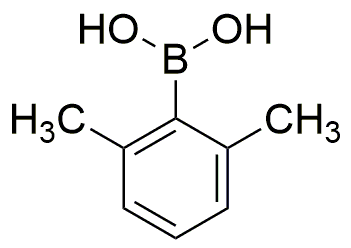2,6-Dimethylphenylboronic acid is widely utilized in research focused on:
- Organic Synthesis: This compound serves as a key reagent in Suzuki coupling reactions, enabling the formation of carbon-carbon bonds essential for creating complex organic molecules.
- Pharmaceutical Development: It plays a critical role in the synthesis of various pharmaceutical intermediates, particularly in the development of anti-cancer and anti-inflammatory drugs.
- Material Science: Used in the production of boron-containing polymers, it enhances material properties, making them suitable for applications in electronics and coatings.
- Bioconjugation: Its ability to form stable complexes with sugars makes it valuable in bioconjugation processes, facilitating the development of targeted drug delivery systems.
- Sensor Technology: This compound is utilized in the design of sensors for detecting biomolecules, offering high sensitivity and selectivity in various analytical applications.
General Information
Properties
Safety and Regulations
Applications
2,6-Dimethylphenylboronic acid is widely utilized in research focused on:
- Organic Synthesis: This compound serves as a key reagent in Suzuki coupling reactions, enabling the formation of carbon-carbon bonds essential for creating complex organic molecules.
- Pharmaceutical Development: It plays a critical role in the synthesis of various pharmaceutical intermediates, particularly in the development of anti-cancer and anti-inflammatory drugs.
- Material Science: Used in the production of boron-containing polymers, it enhances material properties, making them suitable for applications in electronics and coatings.
- Bioconjugation: Its ability to form stable complexes with sugars makes it valuable in bioconjugation processes, facilitating the development of targeted drug delivery systems.
- Sensor Technology: This compound is utilized in the design of sensors for detecting biomolecules, offering high sensitivity and selectivity in various analytical applications.
Documents
Safety Data Sheets (SDS)
The SDS provides comprehensive safety information on handling, storage, and disposal of the product.
Product Specification (PS)
The PS provides a comprehensive breakdown of the product’s properties, including chemical composition, physical state, purity, and storage requirements. It also details acceptable quality ranges and the product's intended applications.
Certificates of Analysis (COA)
Search for Certificates of Analysis (COA) by entering the products Lot Number. Lot and Batch Numbers can be found on a product’s label following the words ‘Lot’ or ‘Batch’.
*Catalog Number
*Lot Number
Certificates Of Origin (COO)
This COO confirms the country where the product was manufactured, and also details the materials and components used in it and whether it is derived from natural, synthetic, or other specific sources. This certificate may be required for customs, trade, and regulatory compliance.
*Catalog Number
*Lot Number
Safety Data Sheets (SDS)
The SDS provides comprehensive safety information on handling, storage, and disposal of the product.
DownloadProduct Specification (PS)
The PS provides a comprehensive breakdown of the product’s properties, including chemical composition, physical state, purity, and storage requirements. It also details acceptable quality ranges and the product's intended applications.
DownloadCertificates of Analysis (COA)
Search for Certificates of Analysis (COA) by entering the products Lot Number. Lot and Batch Numbers can be found on a product’s label following the words ‘Lot’ or ‘Batch’.
*Catalog Number
*Lot Number
Certificates Of Origin (COO)
This COO confirms the country where the product was manufactured, and also details the materials and components used in it and whether it is derived from natural, synthetic, or other specific sources. This certificate may be required for customs, trade, and regulatory compliance.


